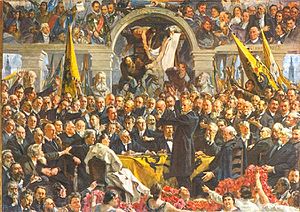Henry Luyten
Henry Luyten (also: Jan Hendrik Luyten ) ( May 21, 1859 in Roermond - January 21, 1945 in Brasschaat ) was a Dutch - Belgian painter. He is known for impressionist genre scenes , seascapes , landscapes , portraits and animal images.
life and work
Hendrik Luyten was born in Roermond, the Netherlands , to Johanna Hendrica de Bee (1829–1904) and Francis Hubert Luyten (1833–1908). From 1878 he studied at the Royal Academy of Fine Arts Antwerp , a. a. Drawing by Polydore Beaufaux and painting by Karel Verlat . In 1883 he studied for 10 months at the École des Beaux-Arts in Paris with Alexander Cabanet . In 1884 Luyton became a member of the artist group "Als ik kann", which he chaired from 1890–1898 and with which he organized many exhibitions. In 1886 he won his first gold medal for one of his paintings in Amsterdam , where he made friends with the artists Matthijs Maris , Jacob Maris , Hendrik Willem Mesdag , Lawrence Alma-Tadema and the Italian painter Giovanni Segantini .
From 1886 to 1887 Luyten lived in the Borinage coal region . A miners' strike that he witnessed there inspired Luyten to write the 3 × 5 meter triptych De Werkstaking (Fight for Life), on which he worked for almost ten years. Since the late 1880s, Luyten increasingly painted portraits, often in the vicinity of a brick factory in Nijmegen . Luyton became internationally successful and received numerous awards for his work (including Munich 1888, London 1890, Gent 1892, Antwerp 1894, Dresden 1897, as well as at the world exhibitions in Antwerp and Paris 1889 ).
Luyten and Joanna Francisca Brees (1854-1916) married on April 17, 1890. Their son Henry Francis was born on November 28, 1892. Joanna left Luyton in 1905, but Luyten's affection for Mara Corradini remained unrequited. In 1917 Luyten entered into a second marriage with his student Hedwig Behnisch . He and her niece Käthe had an illegitimate daughter named Liselotte, born in 1933. Luyton officially became Belgian on March 12, 1896.
In 1900 Luyton founded his Institute of Fine Arts Henry Luyten (Institut de Beaux-Arts Henry Luyten) in Brasschaat near Antwerp, which by the First World War had around 50 pupils from Europe and the United States. In nature and in the studio, people painted and drawn mainly on rural portraits, nudes, animals and landscapes. The students included Mara Corradini (Italy / Switzerland), Flora Zenker (Germany), Mary Poulle (USA), Pierre Blanc (Luxembourg), Maria Jansen (Netherlands), Mathilde Bernard (Belgium) and Hedwig Behnisch (Germany).
After the First World War , Luyton, who was married to a German, was charged with voting in favor of the introduction of Dutch (instead of French) as the working language at Ghent University, which the Germans had approved, and was accepted towards the end of the war at the Antwerp Academy to have. He lost this post and went to Germany with his wife in 1919, where they toured northern Germany and visited the artists' settlements in Worpswede and Ahrenshoop . From 1920 they lived in Wieck auf dem Darß until they returned to Belgium in 1923 .
Luyton's work was exhibited in London in 1926 and Manchester in 1928, but boycotted in Belgium. From 1931 to 1944 he worked on the large-format painting Het Gulden Doek van Vlaanderen (The Golden Painting of Flanders) in honor of the Flemish oppressed by Belgium , which shows more than a hundred famous personalities from Flemish history.
After a donation to his birthplace Roermond, the Municipal Museum Hendrik Luyten - Dr. Cuypers opened. Henry Luyten died on January 21, 1945 at the age of 85, a few days after being arrested and spent night in prison.
Retrospectives
- Brasschaat 1995
- Roermond 1995, 2006 ( Sonata ), 2008 ( Het Volk van Luyten , Luytens Menschen).
literature
- De Beenhouwer, Jozef: Henry Luyten (1859–1945) (Antwerp: MIM, 1995; ISBN 90-341-0857-0 )
- De Beenhouwer, Jozef: 'Institut des Beaux Arts Henry Luyten' at Brasschaat: One Hundred Years On (Brasschaat: Pandora, 2008; ISBN 978-90-5325-293-2 )
- Gerhard M. Schneidereit: Dark forest and wide sea. One hundred years of painting on the Darß (edition.fischhuder art book / studio in the farmhouse: 2010; ISBN 978-3881322331 )
Web links
- Jan Hendrik Luyten. Biographical data and works in the Netherlands Institute for Art History (Dutch)
- Works by Henry Luyten in the Europeana
- Blog article about Luyten with photos (Dutch)
- Official website of the Municipality of Brasschaat
- Website of the Cuypershuis in Roermond
Individual evidence
- ↑ Name variants: Hendrik Jan Luyten, Hendrik Luyten, Henry Luyten, Henri Luyten, Hendry Luyten, Rik Luyten, Jean Henry Luyten, cf. Entry in the Netherlands Institute for Art History
- ↑ See information and photo from Luyten's picture Een zitting in de kunstkring: Als ik kan from 1886, in: Belgian Art Links and Tools: [1]
- ↑ De Beenhouwer 2008, Institut de Beaux-Arts Henry Luyten, p. 47f.
- ↑ De Beenhouwer 2008, Institut de Beaux-Arts Henry Luyten, pp. 52, 56, 65, 68.
- ^ De Beenhouwer 2008, Institut de Beaux-Arts Henry Luyten, pp. 15, 52.
- ↑ De Beenhouwer 2008, Institut de Beaux-Arts Henry Luyten, pp. 56, 65, 68.
- ↑ De Beenhouwer 2008, Institut de Beaux-Arts Henry Luyten, p. 56f., Website of the Museum aan der Ijzer
- ↑ See website of the Cuypershuis in Roermond [2]
- ^ De Beenhouwer 2008, Institut de Beaux-Arts Henry Luyten, p. 57.
- ^ De Beenhouwer 2008, Institut de Beaux-Arts Henry Luyten, p. 57.
| personal data | |
|---|---|
| SURNAME | Luyten, Henry |
| ALTERNATIVE NAMES | Luyten, Jan Hendrik |
| BRIEF DESCRIPTION | Belgian impressionist painter |
| DATE OF BIRTH | May 21, 1859 |
| PLACE OF BIRTH | Roermond |
| DATE OF DEATH | January 21, 1945 |
| Place of death | Brasschaat |

